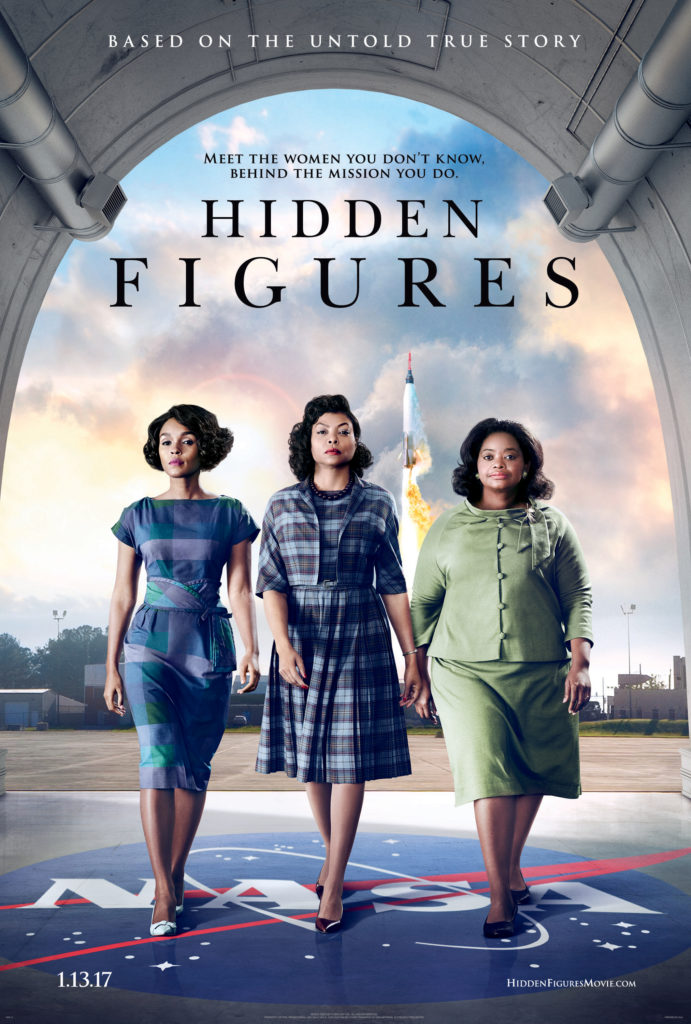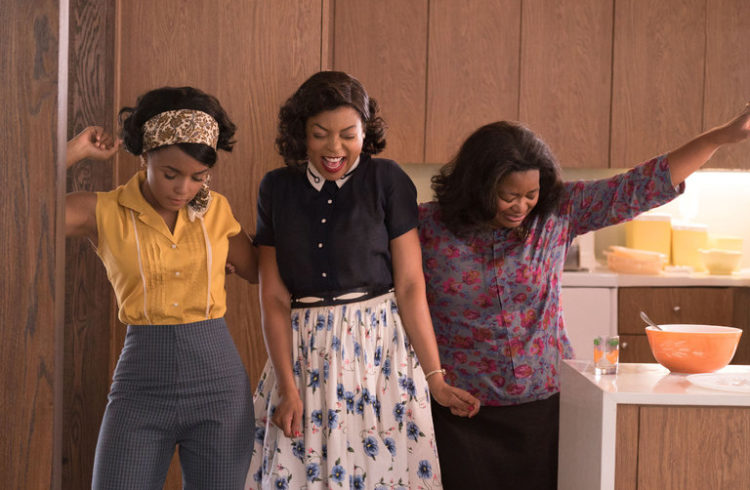I had the pleasure of watching the movie, “Hidden Figures” during opening weekend. It was a birthday gift to myself. I love seeing well written stories and brilliant acting on the big screen, and my heart gets all the more excited when those stories are being told about and by beautiful black people. Such is the case with this movie.
Who Were the Hidden Figures?
Hidden Figures is inspired by the real life stories of three African American women—Katherine Johnson, Dorothy Vaughan, and Mary Jackson—who literally changed the face of NASA, the United States of America, and indeed history.
Throughout the movie, the all-star cast led by Academy award winner, Octavia Spencer (Dorothy Vaughan); an Academy nominee, Taraji P. Henson (Katherine Johnson); and Grammy nominee Janelle Monáe (Mary Jackson) approach the challenges of being black and woman with a great deal of intellect, grace, and even some wit. It addition to telling this great American story and introducing many of us to these American sheroes, the movie provides a history lesson and a glimpse into some of the systemic injustices that remain hidden and why. Hidden Figures is a history lesson into systemic injustices and why they remain hidden. Click To Tweet
Let me begin here: When watching a movie that is based on or inspired by a true story, it is sometimes difficult to determine how much of the movie is historically accurate and how much filler is required to effectively bring the story to light.
We know from reading the Bible that a narrative can begin in one place only to have the story pick up in another place. When that happens, we long to know the in-between (like what transitioned in Jesus’ human life between the time that his parent’s lost him and he was “about his father’s business” in the temple, until the time that he began his earthly ministry in his early thirties). Sometime we are just left wondering. At other times, we try to fill in the gaps as best we can with the information that we do know.
In this instance, there is much to know about these women themselves (especially since Katherine Johnson is still alive), the federal government system in which they were required to operate, and the time period that they grew up in to fill in the unknown gaps with some integrity.
The time period was the early 1960s in America. The focus of NASA and the federal government was the Space Race (how Americans could get into space first). The Russians beat us by successfully having the first human journey into outer space in the spring of 1961. This defeat—what American government leaders saw as humiliation on the world’s stage—along with our concern for national security and distain for Russia was the catalyst that changed the personal and professional lives of these courageous women.

Three Injustices Demonstrated in Hidden Figures
Injustice #1: Black Women and their Hidden Issues
The movie gives a behind the scenes look into the successful launch of John Glenn. The first American into orbit. We know his name. Katherine Johnson was the brains who calculated the math to successfully bring Marine Corps Colonel Glenn back home.
Because of this movie, we now know Mrs. Katherine Johnson as the mathematician who made significant contributions to several of NASA’s aeronautics and space programs, including the Apollo 11 flight to the moon. Katherine first joined the National Advisory Committee for Aeronautics (NACA) team as a human “computer,” and transitioned to Langley Research Center’s Guidance and Navigation Department to do and check the math of her white male colleagues. Her academic depth and brilliance could not be denied.
In the movie, however, that did not stop her peers from trying to marginalize her in other ways. Since she was the only black person in the office, they made sure to provide her with a “colored” coffee pot which they did not fill with coffee. The most blatant injustice displayed on the screen was the simple fact that she lost hours of work (nearly 40 minutes at a time) to literally run back and forth to the only “colored” restroom on the entire NASA campus.
This was an invisible issue to her colleagues because it was not their reality, and the lack of having a restroom near their desk did not negatively impact them. It was not until she was questioned about her regular “absence” that she was able to raise the issue with her supervisors and confront her peers. It took her raising the issue, making a “hidden” issue visible, for real change to take place.
The movie did not indicate that her senior advisor was motivated by a moral code or civil rights, he just believed that changes were needed because collectively they are not getting the job done. They were not the best—coming in second place to Russia, but Katherine could help them be the best, and to do that, she needed to work effectively. Sometimes that is all that’s required—someone who is willing to call out an injustice and someone in a position of authority who can articulate how that injustice is negatively impacting everybody. Sometimes all that’s required is an authority who articulates how injustice impacts everybody. Click To Tweet
Injustice #2: When Black Women do the Work, but others get the Title, Recognition, and Pay
This is a reality that Katherine, Mary, and Dorothy shared. Katherine did the math, but her white male colleague got the title and pay, while his name was the only one listed on the report (even though the numbers were Katherine’s work). Katherine did the work, but the white male initially got the credit. Mary Jackson, the engineer, was faced with the same challenges. When her character was asked by a colleague, “If you were a white male, would you wish to be an engineer?” She replied, “I wouldn’t have to, I’d already be one.”
Faced with the reality of segregated schools, Mary was not able to initially attend the right schools or classes to meet the requirements of the engineering program. Although she was working at the same level and had the ability, she did not share the title or pay of her male counterparts. Her character’s response speaks to a gender issue and the challenges that women at large continue to face in STEM (Science, Technology, Engineering, and Math) careers fields.
The racial dynamic at play was evident in Dorothy’s story as well. She took on the responsibility of serving as an interim supervisor for the segregated NACA, but she was denied the title and pay for at least one year. She was in charge of all the “colored computers,” the African American women mathematicians who contributed to the research at Langley, and influenced the opportunities and upward mobility for other women like Katherine and Mary.
In 1958, Mary Jackson became NASA’s first black female engineer. Dorothy Vaughan was promoted to supervisor in 1949, making her NACA’s first black supervisor, and she headed the computing division nearly a decade before retiring from NASA in 1971.
Injustice #3: Privileged White Women and the Rest of Us
During the time that Dorothy Vaughan, Katherine Johnson, and Mary Jackson provided public service to our country, NASA was undergoing many challenges and changes, some were a result of the limitations and injustices of our American society. These were directly impacted by what legal scholar Kimberlé Chenshaw calls the intersectionality of being black and woman. In other words, they faced injustices because they were black, and they faced injustices because they were female. Because the white women who worked in their career fields, shared the latter injustice, the white women were able to use the former to their benefit.
This dynamic was impossible to miss on screen, and is quite prevalent when black women are discussing a feminist movement that only seems concerned with the issues that negatively impact white women. I recently saw this play out during the 2016 Presidential campaign. By the time we were called to vote, the president-elect had built a resume of negative comments or he could have been held responsible for inciting negative actions against people of color. Within the Christian community, several of us spoke out against these injustices for nearly a year, but it was not until the “video” came out, that white evangelical women began to speak out against him. The video made it personal and a convenient time for them to speak out, even though he had already been hurting many of us.
At some point we (as Christian for sure) have to get to a place of caring, I mean really caring, about the other. Part of that comes from being more aware of other people’s stories and plight, being aware of our own privilege, and naming the gaps and injustices between these two positions. Caring comes from naming the gaps & injustices between our position and the other. Click To Tweet
Good News and Continued Challenges
Hidden Figures provides a lot of good news and hope for us. More than putting beautiful black people on the screen and telling a compelling story, the movie provides hope. It is a history lesson for ways African American stories are often forgotten or neglected in our classroom teaching and history books. African American history is and has always been American history, and therefore we must include and teach it throughout the entire year. It is an inspirational story about what can happen when people see the big picture, and work together towards a greater calling or mission. It shows us what happens when young boys and girls from any background get a great education and have equal opportunities to excel.
It reminds us of how far we have come. Today, NASA is run by an African American male, Administrator Charles Bolden. I know him as Major General Charles Bolden, U.S. Marine Corps retired. He is a Naval Academy graduate, former NASA astronaut, and Christian from Columbia, South Carolina. Things have changed, yet this movie challenges us to confront the issues that we still face. Today, women are still under-represented in STEM career fields. Today, women are not getting equal pay for equal work in every career field. Today, black women are the most educated and underpaid people in the workforce. So Hidden Figures motivates us to press on so these hidden injustices are hidden no more.






Missio Alliance Comment Policy
The Missio Alliance Writing Collectives exist as a ministry of writing to resource theological practitioners for mission. From our Leading Voices to our regular Writing Team and those invited to publish with us as Community Voices, we are creating a space for thoughtful engagement of critical issues and questions facing the North American Church in God’s mission. This sort of thoughtful engagement is something that we seek to engender not only in our publishing, but in conversations that unfold as a result in the comment section of our articles.
Unfortunately, because of the relational distance introduced by online communication, “thoughtful engagement” and “comment sections” seldom go hand in hand. At the same time, censorship of comments by those who disagree with points made by authors, whose anger or limited perspective taints their words, or who simply feel the need to express their own opinion on a topic without any meaningful engagement with the article or comment in question can mask an important window into the true state of Christian discourse. As such, Missio Alliance sets forth the following suggestions for those who wish to engage in conversation around our writing:
1. Seek to understand the author’s intent.
If you disagree with something the an author said, consider framing your response as, “I hear you as saying _________. Am I understanding you correctly? If so, here’s why I disagree. _____________.
2. Seek to make your own voice heard.
We deeply desire and value the voice and perspective of our readers. However you may react to an article we publish or a fellow commenter, we encourage you to set forth that reaction is the most constructive way possible. Use your voice and perspective to move conversation forward rather than shut it down.
3. Share your story.
One of our favorite tenants is that “an enemy is someone whose story we haven’t heard.” Very often disagreements and rants are the result of people talking past rather than to one another. Everyone’s perspective is intimately bound up with their own stories – their contexts and experiences. We encourage you to couch your comments in whatever aspect of your own story might help others understand where you are coming from.
In view of those suggestions for shaping conversation on our site and in an effort to curate a hospitable space of open conversation, Missio Alliance may delete comments and/or ban users who show no regard for constructive engagement, especially those whose comments are easily construed as trolling, threatening, or abusive.